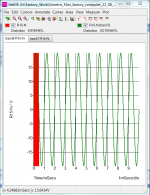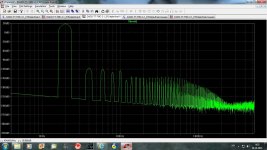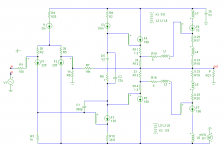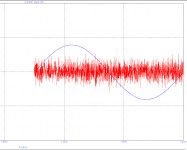Here are the results I got comparing Simetrix with LTspice simulators
Hi Arthur,
Maybe you might also run simulations of Bob's amp (see post 3824), so we could compare your results with the rest of our sims.
Cheers,
E.
Hello Edmond
Its curious that the results get polarized into these two different groups of results.
Regards
Arthur
Its curious that the results get polarized into these two different groups of results.
Regards
Arthur
The user or the tool?
Thanks Arthur.
Let's tabulate the results we got till now (I hope more will come):
THD-1k (in ppm of first 10 harmonics?) of Bob's amp according fig. 19.7
Hmm... Needless to say that these figures don't inspire much confidence in simulator platforms of various brands.
On the other hand, my THD figures obtained from MicroCap were reasonable in line with actual measurements on the 'blameless' amp, Bob's HEC amp and the PGP amp.
I also like to add that, at least to me, a figure of 26ppm doesn't sound overly optimistic.
>Its curious that the results get polarized into these two different groups of results.
Sure. But who's to blame? The user or the tool?
Cheers,
E.
Thanks Arthur.
Let's tabulate the results we got till now (I hope more will come):
THD-1k (in ppm of first 10 harmonics?) of Bob's amp according fig. 19.7
Code:
Cadence-1: 259.6 (post 3826)
Cadence-2: 81.8 (post 3844)
Cadence-3 190.6 (post 3850)
MicroCap: 26.8 (post 3837)
LTspice: 26.6 (post 3824)
Simetrix: 190.0 (post 3863)Hmm... Needless to say that these figures don't inspire much confidence in simulator platforms of various brands.
On the other hand, my THD figures obtained from MicroCap were reasonable in line with actual measurements on the 'blameless' amp, Bob's HEC amp and the PGP amp.
I also like to add that, at least to me, a figure of 26ppm doesn't sound overly optimistic.
>Its curious that the results get polarized into these two different groups of results.
Sure. But who's to blame? The user or the tool?
Cheers,
E.
MC10
Hello Edmond
Out of curiosity have you tried MC10 demo , it would be curious to see what results it gives.
Regards
Arthur
Hello Edmond
Out of curiosity have you tried MC10 demo , it would be curious to see what results it gives.
Regards
Arthur
MC9 vs MC10
Hi Arthur,
As for Bob's amp 19.7, THD & 1kHz and BW = 10kHz
MC 9: 26.778ppm
MC10: 26.778ppm
As you can see, not much difference. 😉
Cheers,
E.
Hi Arthur,
As for Bob's amp 19.7, THD & 1kHz and BW = 10kHz
MC 9: 26.778ppm
MC10: 26.778ppm
As you can see, not much difference. 😉
Cheers,
E.
Michael
The deal with simulators and accurate THD sims is that you need "good models" without them you dont get accurate simulated results. I am not sure of the quality of the parts used in the last simulation exercise but I dont think its fair to draw the conclusion that simulators are unreliable for THD simulations.
The deal with simulators and accurate THD sims is that you need "good models" without them you dont get accurate simulated results. I am not sure of the quality of the parts used in the last simulation exercise but I dont think its fair to draw the conclusion that simulators are unreliable for THD simulations.
The Good, The Bad And The Ugly
Hi Arthur,
As for THD analysis, there are good AND unreliable simulators. Please have a look at this thread:
http://www.diyaudio.com/forums/solid-state/29119-distortion-simulation-ltspice.html#post336260
Here are some excerpts:
"After following some tips from the LTSpice mailing list, I see no practical limitation from the FFT accuracy (in LTSpice).
With compression off, alternative solver on, running
.tran 0 12m 0 .1u gives .fourier results down to 3E-6 (110dB dynamic range). The graphical FFT, selecting 65536 points and Hann window, gives a "noise floor" of -200dB. And if you join Bernhard's Church of the Merciless Noise Killing, he will most likely give you the setup for getting down to -300dB.
But these are only numbers in a theoretical game, as the active devices' models are not anywhere near this accuracy.
Regards,
Peter Jacobi"
That's okay, but now look at this one:
"Regarding the accuracy of the FFT (needed for THD analysis) within PSPICE I found the following:
http://www.[B]orcadpcb.com[/B]/kb_articles/020019.asp?bc=F
an excerpt:
Simulation accuracy is limited to about 3-3.5 digits (60-70dBc). The accuracy can be improved by tightening tolerances and taking the above considerations to extremes, but not by very much. This may not be considered sufficient for some applications, but keep in mind that even the best simulation models are probably not accurate enough to provide better
[...]
Regards
Charles "
3.5 digits correspond with an accuracy of ~300ppm. If this is true, it explains a lot! Orcad
Cheers,
E.
Michael
The deal with simulators and accurate THD sims is that you need "good models" without them you dont get accurate simulated results. I am not sure of the quality of the parts used in the last simulation exercise but I dont think its fair to draw the conclusion that simulators are unreliable for THD simulations.
Hi Arthur,
As for THD analysis, there are good AND unreliable simulators. Please have a look at this thread:
http://www.diyaudio.com/forums/solid-state/29119-distortion-simulation-ltspice.html#post336260
Here are some excerpts:
"After following some tips from the LTSpice mailing list, I see no practical limitation from the FFT accuracy (in LTSpice).
With compression off, alternative solver on, running
.tran 0 12m 0 .1u gives .fourier results down to 3E-6 (110dB dynamic range). The graphical FFT, selecting 65536 points and Hann window, gives a "noise floor" of -200dB. And if you join Bernhard's Church of the Merciless Noise Killing, he will most likely give you the setup for getting down to -300dB.
But these are only numbers in a theoretical game, as the active devices' models are not anywhere near this accuracy.
Regards,
Peter Jacobi"
That's okay, but now look at this one:
"Regarding the accuracy of the FFT (needed for THD analysis) within PSPICE I found the following:
http://www.[B]orcadpcb.com[/B]/kb_articles/020019.asp?bc=F
an excerpt:
Simulation accuracy is limited to about 3-3.5 digits (60-70dBc). The accuracy can be improved by tightening tolerances and taking the above considerations to extremes, but not by very much. This may not be considered sufficient for some applications, but keep in mind that even the best simulation models are probably not accurate enough to provide better
[...]
Regards
Charles "
3.5 digits correspond with an accuracy of ~300ppm. If this is true, it explains a lot! Orcad

Cheers,
E.
Last edited:
Michael
The deal with simulators and accurate THD sims is that you need "good models" without them you dont get accurate simulated results. I am not sure of the quality of the parts used in the last simulation exercise but I dont think its fair to draw the conclusion that simulators are unreliable for THD simulations.
This is what Nelson pass has to say here http://www.diyaudio.com/forums/solid-state/29119-distortion-simulation-ltspice.html#post336288 :
....SPICE THD accuracy even with good models is excreble....I don't recommend trying to perform other than crude distortion
analysis with simulation. From my experience, you can't depend
on such numbers, and there are a few texts written that
address these issues, two being Kielkowski's "Spice: Practical
Device Modeling" or Tuinenga's "Spice: A Guide to Circuit
Simulation and Analysis using PSpice".
Both these books are fairly explicit about the limitations of
distortion analysis with Spice. If you really want to know, I
recommend that you build the circuit.
Last edited:
....SPICE THD accuracy even with good models is excreble....
when you argue if it is 0.01 or 0.001%THD
it makes no sense.
Better look if harmonics distribution is descending
this is the marker of the performance

I belive Scott Wurcer has claimed op amp sims at AD predict distortion to better than -60 dB
of course when you own the fab, can set process enginners to modeling for you...
of course when you own the fab, can set process enginners to modeling for you...
I belive Scott Wurcer has claimed op amp sims at AD predict distortion to better than -60 dB
of course when you own the fab, can set process enginners to modeling for you...
That's certainly possible. I've seen here at the university analog simulations using a tuned Cadence PSpice package and the Europractice AMIS libraries (they are not device level, but cell macromodels) that go down to 1ppm and match the chip measurements to within 5%.
That's another world and, as I've already said, it costs millions to reach there. What is available to DIYers (free simulators and factory models) is just a gross approximation and, under the circumstances, I think a 0.01% absolute precision of the distortion prediction is about the best that can be expected. Anything beyond that is simply a random number that may (by chance) or may not fit the reality on the bench.
Though, in the DIY world, relative distortion simulation results are indeed very useful in tuning an analog design. For such, it doesn't really matter if it's LTspice, PSpice, Simetrix, etc...
Last edited:
Hello Edmond
The other thing about Cadence is that their best simulator is called "Spectre" and not Pspice.
This is what I am told is the industry standard for analog IC design. This is what Scott Wurcer uses at ADI. Earlier versions of this simulator make a claim on THD sim accuracy down to least -120dB (with of course good models) .
Regards
Arthur
The other thing about Cadence is that their best simulator is called "Spectre" and not Pspice.
This is what I am told is the industry standard for analog IC design. This is what Scott Wurcer uses at ADI. Earlier versions of this simulator make a claim on THD sim accuracy down to least -120dB (with of course good models) .
Regards
Arthur
Hello Edmond
The other thing about Cadence is that their best simulator is called "Spectre" and not Pspice.
This is what I am told is the industry standard for analog IC design. This is what Scott Wurcer uses at ADI. Earlier versions of this simulator make a claim on THD sim accuracy down to least -120dB (with of course good models) .
Regards
Arthur
Hi Athur,
I'm not impressed by -120dB. MicroCap 'does' -197dB on a clean sine.
May I suggest that we redo the simulations of Bob's amp, but this time with distortionless components (VCCS, CCCS, etc) ?
Then we get a notion of the numerical accuracy of the FFT implementation.
Cheers,
E.
THD Ideal amp
Here's distortion of Bob's amp with ideal components (that is, without any distortion). THD @ 1k = -210dB, BW = 10kHz. Simulator: MicroCap.
The graph below shows the output voltage (20Vpk) and the residue*1e11 (just rounding noise).
Now, let's see what LTspice, Orcad-Cadence and Simetrix can do.
Cheers,
E.
PS: The inductors are 25nH
edit1: -197db in post 3877 is wrong (due to mental arithmetic). It should be -214dB
edit2: F1, F2 etc. are CCCSes.
Here's distortion of Bob's amp with ideal components (that is, without any distortion). THD @ 1k = -210dB, BW = 10kHz. Simulator: MicroCap.
The graph below shows the output voltage (20Vpk) and the residue*1e11 (just rounding noise).
Now, let's see what LTspice, Orcad-Cadence and Simetrix can do.
Cheers,
E.
PS: The inductors are 25nH
edit1: -197db in post 3877 is wrong (due to mental arithmetic). It should be -214dB
edit2: F1, F2 etc. are CCCSes.
Attachments
Last edited:
when you argue if it is 0.01 or 0.001%THD
it makes no sense.
Better look if harmonics distribution is descending
this is the marker of the performance
How do you figure that out or could you explain how in the audio press so called amplifiers with non decending harmonic spectrums or even worse predominant 3rd harmonic spectrum seem to reak up best sound and best buy awards, this accross various publications ??? Some of the writers even mention their surprise at this, I will not mention who as some dont like to be mentioned here. Most of these amps show very low distortion, near absence of high order harmonics due to their very low THD figures and high speed.
- Home
- Amplifiers
- Solid State
- Bob Cordell Interview: Error Correction




